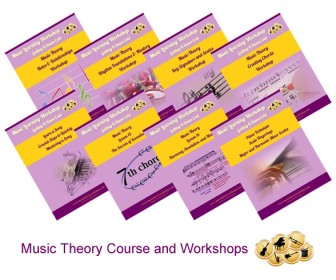Beat and Time for Note Symbols
![]() So let’s explore the music theory math next and give all these symbols some meaning.
So let’s explore the music theory math next and give all these symbols some meaning.
Music Theory and Music Math:
Music is mathematical and is in the rhythm we learn here and the sound pitches we will learn about in the music staff.
Here we start with the concept of note time value. Our basic understanding starts with the symbols used above where we can assign time to the note. First let’s look at the relationship of the notes and rests to each other.
Note Duration and Time Relationships

= Whole note and rest: represents the time for a whole measure and is held for four counts of the measure.
= Half note and rest: 1/2 of a whole note/rest, 2 half notes make a whole note/rest.
= Quarter note and rest: 1/4 of a whole note/rest,1/2 of a half note/rest, 4 quarter notes make a whole note.
= Eight note and rest: 1/8 of a whole note/rest, 1/2 of a quarter note, it takes 8 eighth notes to make a whole note.
= Sixteenth note and rest: 1/16 of a whole note,1/2 of an eighth note, 1/4 of a quarter note, it takes 4 sixteenth notes to make a quarter note, ![]() (4 sixteenths beamed together)
(4 sixteenths beamed together)
Examples of notes on the staff each equal in count:
Add a Dot after a note
“.“ = The Dot: Add one half the value of the note attached to the dot.
Here’s the example of the dot: a dotted half note ![]() is a half note plus a quarter note and is held for 3 full counts of a quarter note. Here are more dotted notes:
is a half note plus a quarter note and is held for 3 full counts of a quarter note. Here are more dotted notes:

Dotted quarter note: quarter note plus an eight note.
Dotted eight note: eight note plus a sixteenth note.
Yes, the power of two, that’s the math of basic rhythm. We will introduce other mathematical divisions later in our journey. As you can see the most basic way to describe rhythm and note patterns is by divisions of 2.


